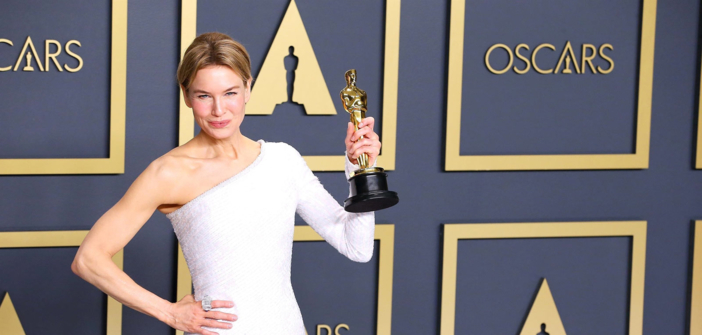Judy is interested in the latest tour in London of the “fiancée of America,” far from the pomp of her younger years. The film weaves the portrait of a woman, masterfully interpreted by Renée Zellweger, destroyed by the Hollywood system.
“We’re not in Kansas anymore.” This famous phrase uttered by Judy Garland in The Wizard of Oz (1939) perfectly applies to the actress’s career depicted in Judy. Directed by the British Rupert Goold, the film is a classic biopic. Both the direction and the screenplay are in line with Hollywood standards—simple, effective, and risk-free.
Only the stage performances of the heroine stand out from the rest, likely due to the director’s extensive career in theater production. But the entire film rests on the astonishing performance of Renée Zellweger.
The Oscar-winning actress for Cold Mountain in 2004 majestically embodies a worn-out Judy Garland, driven by the energy of despair. Transcended on stage, she lives a nightmare offstage. Her shoulder movements, throat tightenings, and the way she moves within the set are all elements that haunt the mind of a spectator captivated by this physical performance. Her renditions of Judy Garland’s iconic songs are spectacular, whether it’s the festive Trolley Song or the magnificent Somewhere Over the Rainbow.
The unrecognizable Bridget Jones actress thoroughly deserves her Oscar for Best Actress.
A Destructive and Vicious System
Judy Garland is a child star. She grows up on Hollywood film sets, and her career is managed by one of the greatest producers in cinema history: Louis B. Mayer. Her career is managed, but so is her life. Judy showcases, without overdoing it, the excessive control of the studios over young Judy’s life. Unallowed to eat to avoid gaining weight, appetite suppressant pills, and other arranged meetings to provide gossip to the press are her daily life at MGM during the shooting of The Wizard of Oz.
She occasionally oversteps her boundaries but, despite her desires for freedom, always ends up accommodating the vicious conditions of the system out of fear of losing her movie star status.
These scenes aim to explain the origins of the troubles Judy Garland faces at the end of her career. She has become addicted to pills and alcohol.
Broke and exhausted, she takes her children from stage to stage and from hotel to hotel until a project in London is proposed to her. The vicious circle of the system perpetuates. “I have to leave my children to earn enough money to be with my children?” she laments.
Having left for money, her most pressing need resurfaces: her perpetual quest for public adoration. Obsessed with the stage and fame, she does everything to be the center of attention and clings to anyone who shows her interest. Until her addictions overtake her nerves.
The film presents the life of a woman destroyed by a system. It proves to be a true pact with the devil, from which it is impossible to escape. Terrifying.
Paul Guianvarc’h


